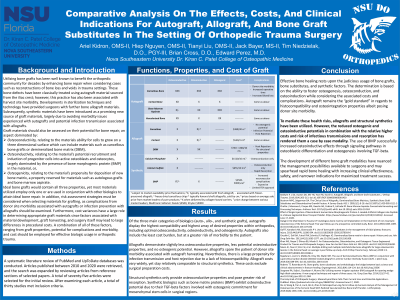General Surgery
Comparative Analysis On The Effects, Costs, And Clinical Indications For Autograft, Allograft, And Bone Graft Substitutes In The Setting Of Orthopedic Trauma Surgery

When determining the graft of choice, osteoconductivity, osteoinductivity, ostegenicity, graft price, and morbidity should all be considered. Subsequent sterilization techniques and technology have provided surgeons promising allograft options. Furthermore, synthetic options have been introduced in an attempt to decrease the morbidity of autografts and decrease the transmission of disease during allograft procedures.
Methods or Case Description: A systematic literature review of PubMed and UpToDate databases was conducted. A total of seventy-five articles, published in 2010-2020, were selected for the initial review. After examining each article, a total of thirty studies met inclusion criteria.
Outcomes: Autografts displayed the highest compatibility and desired properties within orthopedics, including optimal osteoconductivity, osteoinductivity, and osteogenicity. Autografts also include the least cost but at a greater risk of morbidity to the patient. Allografts demonstrated slightly less osteoconductive properties, less potential osteoinductive properties, and no osteogenic potential. However, allografts spare the patient of donor site morbidity. Synthetic biologics such as bone matrix proteins (BMP) exhibit osteoinductive potential and share similar costs to allografts.
Conclusion: Effective bone healing rests upon the judicious usage of bone grafts, bone substitutes, and synthetic factors. The determination is based on the ability to foster osteogenesis, osteoconduction, and osteoinduction while considering the associated costs and complications. Autograft remains the “gold standard” in regard to histocompatibility and osteointegration properties albeit posing donor site morbidity. Allografts and structural synthetics have reduced osteogenic and osteoinductive potentials in but pose less donor morbidity risks. The use of BMP successfully increased osteoinductive effects through signaling pathways in osteoblastic differentiation and osteogenesis involving TGF-beta. The development of different bone graft modalities may spearhead rapid bone healing with increasing clinical effectiveness, safety, and narrower indications.
- AK
Ariel Kidron
Osteopathic Medical Student
Kiran C. Patel Nova Southeastern University College of Osteopathic Medicine
Aventura, FL, US - HN
Hiep Nguyen
Kiran C. Patel Nova southeastern University College of Osteopathic Medicine
Aventura, FL, US - TL
Tianyi Liu
Kiran C. Patel Nova southeastern University College of Osteopathic Medicine
Aventura, FL, US - JB
Jack Bayer
Kiran C. Patel Nova southeastern University College of Osteopathic Medicine
Aventura, FL, US
